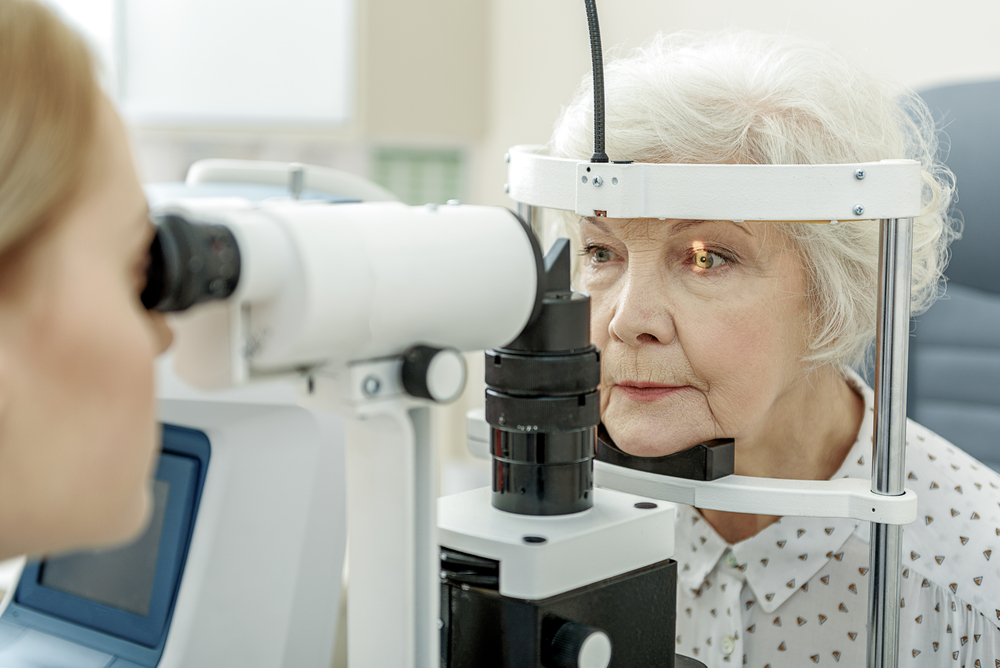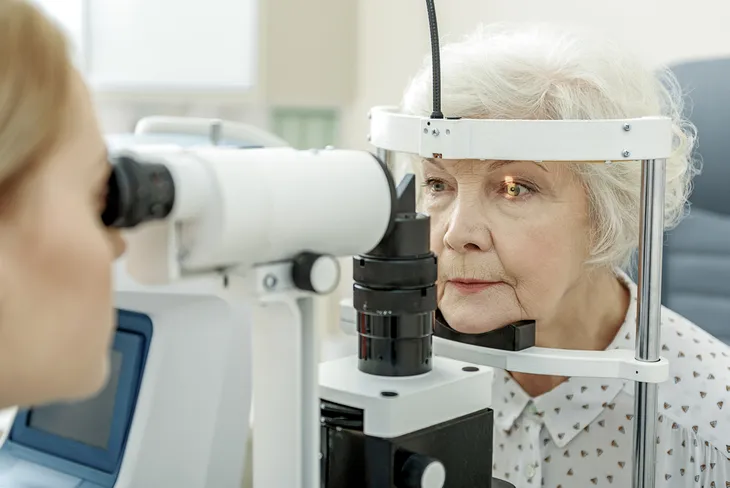Cataracts are a vision condition that affect the lens of the eyes. Protein in the lens builds up making your vision cloudy and blurry, fading colors, increasing your sensitivity to light, and making it difficult to see at night. This happens gradually over time, sometimes making it difficult for people to notice the changes in their eyesight.
Cataracts are a very common condition in older adults. Half of Americans over 80 years of age either have cataracts or have had cataract removal surgery, according to the National Eye Institute. Thankfully, cataract surgery is safe and can correct vision problems caused by the cloudy lens. There are many cataract causes and risk factors that can increase the chances of a diagnosis. Keep reading to learn more about them and what you can do to minimize the likelihood of developing cataracts.
Causes and risk factors for cataracts (in no particular order) are…
Advanced Age
The most common risk factor related to cataracts is advanced age. As you get older, the proteins in the lens of your eye clump together making it difficult to see. According to the National Eye Institute, this is a normal occurrence that begins at around 40-years-old. Every decade after age 40, your chance of developing cataracts increases, with approximately 24-million Americans diagnosed each year.
Once you reach 60-years-old, it is recommended to get a dilated eye exam every 2-years. These exams are simple and painless and will detect cataracts and other eye problems.
Family History
Just like advanced age, family history is another risk factor that you don’t have any control over. If your parents, grandparents, or other family members have been diagnosed with cataracts, you are also more likely to be diagnosed. It’s a good idea to talk to your family about their health history in order to learn more about the conditions and diseases that you may be at risk for.
Thankfully, the National Eye Institute explains that early cataracts can be treated at home with some simple changes, such as brighter lights, anti-glare sunglasses, and magnifying lenses. If your cataracts make it too difficult to see, then surgery is the best option. Let your eye doctor know about any family history of cataracts and other eye conditions to help determine the best care for you.
Smoking
It’s no secret that smoking is an unhealthy habit that can seriously affect your lungs and heart. However, what isn’t as well known is that smoking can also cause cataracts. Researchers have found that smoking changes the cells within the lens. According to the CDC, people who smoke are two to three times more prone to be diagnosed with cataracts than a nonsmoker. This is just another excellent reason to quit smoking (or never start), and work towards a healthier lifestyle.
If you currently smoke, there’s still time to quit! Once you quit, your chances of developing cataracts will decrease. WebMD refers to one study which showed that smokers who had quit for 20 years or more were able to drop their chances of developing cataracts from 42-percent down to 21-percent. Talk to your doctor about options for quitting smoking and decreasing your chances of developing cataracts.
Alcohol
Drinking beer, wine, and spirits can be a fun social activity but needs to be done in moderation. Research has shown that the more you drink, the more likely you are to get cataracts. In fact, one study reported by Harvard found that women who drank one or more alcoholic drinks per day were 11-percent more likely than non-drinkers to have cataract surgery.
Consuming too much alcohol can do more than just affect your eyes. Cutting down on your intake will benefit your liver, stomach, and so much more. Talk to your doctor if you are having a hard time reducing your alcohol intake or wonder if you might have alcoholism. They will be able to help you develop a plan to get you on the right track to a healthy lifestyle.
Sun Exposure
Grab your sunglasses and hat because too much UV light is another cause of cataract development. It takes years for cataracts to develop, so it may seem like something as simple as outdoor eye protection couldn’t make a long-term difference. But that couldn’t be further from the truth, as every time you go outside into the sun without eye protection, you are increasing your risk for cataracts.
Some prevention tips are to use UV blocking sunglasses and wear a hat every time you go outside, even during the cold months. UV light can damage your eyes year-round. Clouds do not block the dangerous UV light, so protection should be worn, even on cloudy days. Lastly, look out for other people who may not be as in tune with their surroundings like children and the elderly. No one is immune to the sun’s dangerous rays. Everyone needs to wear sun protection!
Diabetes
Diabetes is a disease where the body is unable to make enough of the hormone that helps manage your blood sugar. Excess blood sugar can lead to multiple health conditions, including cataracts. This really illustrates one of the many reasons why it’s so important to manage your blood sugar levels if you have diabetes. Cataracts cause clouding in the lens of the eye, but with adequate blood sugar control, you may be able to prevent this.
Anyone can get cataracts, but people with diabetes can get them at a younger age and with faster progression. Knowing your risk factors and the causes of cataracts, such as diabetes, can help you stay one step ahead of the game and improve your health and diabetes management. Remember to report any signs of cataracts to your doctor, such as cloudy vision or glare.
Eye Injury
It’s not uncommon for someone to develop cataracts after an eye injury. Also known as a traumatic cataract, the clouding and yellowing of your sight happens after an object breaks through and injures the lens. Thankfully, these types of cataracts don’t usually cover the entire eye and their development is related to the severity of the eye trauma.
After you have recovered from an eye injury, you should learn all of the signs and symptoms of cataracts. As we’ve discussed earlier, some of the signs are cloudy vision, color changes, double vision, and difficulty seeing at night. If you believe that you are having side effects from the injury then make a call to your doctor to discuss your concerns.
Steroids
Steroids are used to treat quite a few conditions that involve swelling within the body, including asthma and inflammatory bowel disease. Prednisone, a common oral steroid, can cause cataracts as one of its lesser known side effects. Typically, when you hear about steroids you think of bodybuilders and the well-known side effects, such as increased appetite and acne. If you regularly take steroids, make sure that your eye doctor is aware.
Like many of the other causes and risk factors for cataracts, if you are on steroid treatment it is not a guarantee that you’ll develop cataracts. In fact, VeryWell Health reports that if you do develop a cataract while taking steroids, lowering the dose or stopping the steroid treatment can stop the growth/progression of the cataract.
Radiation Exposure
Unfortunately, many people are exposed to radiation every day. Cancer patients and hospital employees who work near computerized tomography (CT) machines are two groups who are exposed to radiation. According to the Radiation Effects Research Foundation, “symptoms can appear as early as one or two years following high-dose exposure and many years after exposure to lower doses.”
There is no known minimal radiation exposure that is safe in regards to the formation of cataracts. If you can’t avoid radiation exposure because of your job or because of cancer treatment or other diseases, talk to your employer or doctor about ways to minimize the exposure to your upper body and head.
Congenital Cataracts
The Mayo Clinic reports that babies born with cataracts or children who develop them have an eye condition called congenital cataracts. These cataracts are typically associated with infection during pregnancy or because of genetics. Other conditions such as myotonic dystrophy, neurofibromatosis type 2, galactosemia, and rubella can cause congenital cataracts.
Congenital cataracts may not actually affect a baby or child’s eyesight. However, doctors do recommend removing the cataract once they are found to prevent any further growth that could impair vision.
Cataract Surgery
Cataract surgery in and of itself puts you at a higher risk for developing another cataract. It seems a bit counterintuitive, but it’s true. WebMD explains, “cataract surgery removes the front part of the lens but leaves the back in place. That’s where you may get a secondary cataract…” If this happens, you’ll have similar symptoms, including cloudy vision.
WebMD adds that to repair the secondary cataract you’ll need a surgery called YAG laser capsulotomy. “Your doctor uses a laser to create a hole in the back of the lens capsule. That lets light pass through so you can see normally. It’s painless and takes about 5 minutes,” says WebMD.
How to Lower Your Risk
Now that you know the risk factors and causes for cataracts it’s time to learn how you can lower your risk. Health care providers recommend wearing sunglasses and a hat to block the sun’s harmful UV rays. Make positive lifestyle changes by eating healthy, minimizing alcohol intake and quitting smoking.
There are many cataract risk factors that you can’t avoid, such as family history. Get a routine eye exam and don’t fret if your eye doctor finds a cataract. Surgery is incredibly successful with minimal downtime. Most people go home the same day as their cataract surgery, and their vision is vastly improved. (Here’s some more information on Ways to Protect Your Eyes and Maintain Eye Health).















